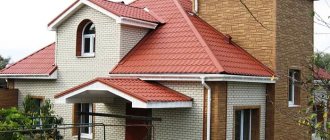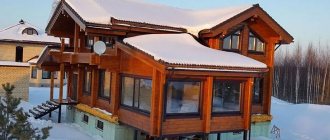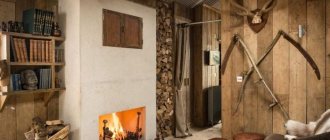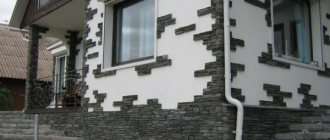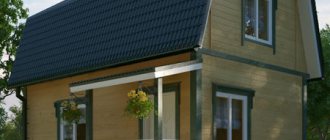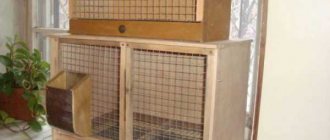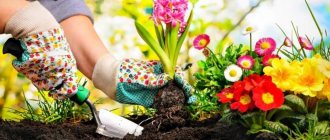Home » Building a house » Categories » Building facade
Building materialsBuilding facade
Annie Cooper 04/30/2020
6566 Views
SavingSavedRemoved 1
The most common material for cladding building facades is plaster, but it is not always the best solution. In winter, “wet work” cannot be carried out; a thick layer with reinforced lattice will still flake and crack, not providing even minimal thermal insulation. Composite finishing materials – fiber cement panels – do not have all these disadvantages. We will look at how to use them correctly for exterior decoration in the material.
Why is this material so popular?
Fiber cement panels are practical, require minimal maintenance, are durable, and are easy to use. A significant advantage is that fiber panels are multi-textured; when used, you can choose any color and texture for the exterior decoration of houses and buildings. For example, to model a fiber facade like a rock; stone, brick, wood, plaster surface. It can be repainted; the raw materials are completely environmentally friendly and can withstand any weather conditions.
Where can fiber cement panels be used?
Imitation of wood trim with fiber cement siding
Facade fiber cement boards are used to decorate facades. Fiber cement siding is suitable for many construction and finishing processes, for example:
- Landscape design. Thanks to the use of fiber cement panels, it is possible to create an imitation of natural wood for the decoration of structural structures, recreation areas, gazebos, and garden details; make fencing for bridges, verandas, terraces;
- Application in functional areas and for interior decoration. Fiber cement panels are harmoniously combined with other building materials, which allows you to create spectacular interior solutions for various areas, using a diverse color palette and texture. With its help, window and door openings are distinguished, different colors are used in several parts of the building; combined with decorative plaster, facade tiles, basement, and vinyl cladding. Fiber cement facade panels can be textured, smoothly painted, with stone inclusions;
- Design of fences and fences. Fences look similar to wood, but are not susceptible to rotting or cracking. Fiber cement boards do not require treatment to protect against fire, are durable, and do not dry out over time;
- Fiber cement brick siding is successfully used in the design of new buildings and offices; restoration and thermal insulation of old premises, private houses.
Decor
When studying the appearance, the fiber cement non-combustible panel is divided into the following categories:
- Imitation of stone masonry. There are many options in this category. The criteria for distinguishing them are as follows: shape, parameters of the “stones,” color, degree of detail, texture specifics.
- Imitation of brickwork. White, yellow and red variants are often found here, and other colors are less common.
- Imitation of painted wood. This category is also called siding panels.
- Fiber cement with stone chips. Their differences: colors, fraction parameters, presence of inclusions.
- Products of a single color and with a “plaster” texture.
Products of similar color are façade panels with marble chips. They are less often used to decorate private houses. Fiber cement facade is suitable for both office and multi-storey residential buildings.
Technical characteristics and basic composition of fiber cement boards
The main parameters of fiber siding The
multi-component composition is based on cement (lightweight concrete), which makes up from 60 to 90% of the mixture, the rest is made up of reinforcing fibers from synthetics or cellulose, sand, mica, and mineral additives. Additional components may vary by vendor. The ratio of ingredients in the composition affects the density of the final product.
Weight and dimensions
The width of one fiber cement board is 20 centimeters, thickness is 0.8 cm. These parameters are constant; for some companies they may differ slightly. Knowing the density (for example, 1.65 g/cm³), the mass of one fiber cement panel is calculated. With a length of 180 cm, weight - 4.8 kg; 300 cm - 7.9 kg and so on. Common parameters: size 45.5x303x1.4 cm, weight - 22 kilograms.
Flammability of the material
Fiber cement siding is fireproof. The components in its composition are not subject to melting, do not ignite, and do not spread fire.
Main components
Fiber cement is a composite material. The main components used in its production are:
- dense fibers (fiber);
- mineral fillers;
- cement holding the structure together.
Fibers are obtained by impregnation with special solutions (zinc chloride, sulfuric acid, calcium thiocyanate) and further pressing several layers of paper or cardboard from pulp and wood pulp. Due to the random arrangement of cellulose fibers, the fiber has high bending resistance; it prevents linear mechanical stretching and thermal expansion of the material, performing a reinforcing function and being responsible for the rigidity of the finished slabs.
Below you can see the appearance of fiber cement panels:
Here you can view the full catalog of KMEW fiber cement panels..>>
The use of fillers facilitates the design and improves the performance characteristics of the panels: it imparts internal plasticity, increases elasticity and flexibility. Cement is responsible for the strength and moisture resistance of products. This production allows us to obtain a very durable, yet lightweight and flexible material.
Distinctive features from other species
Exterior finishing of a building with fiber siding
Compared to vinyl siding, fiber siding does not require the use of additional elements during finishing; it has a larger mass, which makes it possible to ensure resistance to mechanical and impact loads. There is a wide color palette: there are cold, neutral and warm shades of any colors, as well as bright ones that are as close as possible to the natural range (shades of natural wood, stone, brick, marble, walnut, pear, ebony, light oak, etc.) . Coloring occurs in six layers, so the color fastness is maintained for a long time. The strength of fiber cement panels along the entire perimeter, a flat, smooth surface is achieved using a press at high pressure in autoclaves.
Characteristics
Well, advantages are advantages, and technical characteristics are above all. Heat-resistant fiber cement sheets proudly demonstrate the following technical characteristics:
- class – NG (non-combustible material);
- density – 1.5 g/cm3;
- tensile strength – from 22 MPa;
- impact strength – 2 kJ/m2;
- frost resistance - from 100 cycles;
- moisture absorption – from 8%, but not more than 20% of the total mass;
- temperature regime – -60...+80°С;
- weight 1 m2 – 16–24 kg;
- service life – more than 60 years;
- color retention - up to 60 years.
Quite good, isn't it?
Types of fiber cement boards and differences from each other
Imitation of FTP for various materials
Fiber cement boards from different companies differ from each other in density, ductility, and bending strength due to different compositions.
The cellulose present inside the filler helps to significantly reduce the expansion of fiber siding during sudden temperature changes and makes it more rigid in bending. Mineral additives provide plasticity.
Also, models from different manufacturers differ in width, thickness and weight (including per square meter); different ability to expand from moisture and temperature, frost resistance; elasticity; at a price. Different companies provide different guarantees for the life of the product (mostly up to 50 years).
Technological production process
Composite plate
Fiber cement panels are produced industrially by pressing or using an autoclave. In order to obtain a uniform structure and density of siding, the raw materials (cement, cellulose and sand) are mixed, molded and rolled out.
Then the resulting layer of raw fiber cement is cut on a conveyor belt into separate panels of specified parameters. The slab blanks are stacked.
The stacks are pressed under a pressure of 600 N/cm2 (approximately 59 atmospheres) at a temperature not lower than 170 degrees. During the pressing process, excess moisture is removed from the material, uniform density is created and strength is enhanced.
The next production step is the accelerated process of hardening the panels in a chamber for thermal and humidity treatment. It is during this step that the material acquires hygroscopic properties.
Then the fiber cement is sanded and painted with smooth or textured paint. As additional protection from external negative influences, the manufacturer can coat the siding with varnish, including anti-vandal varnish.
Samples of texture and color
Depending on the applied pattern, the panels can imitate:
- masonry
- tree
- brick
- stone chips
- plaster
- plain coloring
The decorative texture of composite cladding - an imitation of other building materials - is created through the use of patterns during pressing.
Ready-made slabs are:
- laminated with vinyl coating or with a textured surface
- with normal and improved resistance to wet environments
- small-, large-sized, in the form of siding panels
- regular and with protrusions for clamps
- with normal and increased levels of fire resistance (limit – 120 minutes)
Advantages with disadvantages
Positive characteristics of fiber cement boards:
- Low thermal expansion, which ensures constant and normal dimensions;
- Non-flammable, safe, non-toxic;
- Frost-resistant, have low water absorption. Corrosion resistant;
- Characteristics and appearance remain unchanged under different weather conditions;
- Resistant to fungi, bacteria, insects;
- Fiber cement boards are not empty inside, they are dense and rigid. They are highly resistant to mechanical damage, strong, and do not bend;
- The color is permanent and the products do not require repainting for a long time. Beautiful, aesthetic, stylish, have a decent appearance.
Disadvantages of fiber cement boards:
- High price. Cheaper models are made without a protective layer, because of this their linear deformation is approximately 2%, the color becomes duller much faster, and the level of hydrophobicity is lower;
- Additional processing of joints, cuts, places where fasteners are installed;
- A large mass of siding products creates a load on the building and requires a sheathing of increased strength.
Advantages and disadvantages of fiber cement
Fiber cement panels
Panels made of cement and fiber were created as a replacement for plaster, superior to this material in terms of performance characteristics for exterior finishing. Advantages and disadvantages of fiber cement over other types of cladding:
Advantages:
- Durability . The material can last about 50 years without changing its physical and chemical properties
- Impact resistance . Cellulose fibers provide a reinforcing effect
- Flexibility . The slabs can be bent to match the curves of the façade as much as possible.
- Minimum load on supporting structures . The panels are quite light, which makes them a convenient material for installation and transportation.
- Fire resistance . Fiber siding, in addition to decorative, also performs a protective function, protecting the building from fire
- High vapor permeability and the ability to quickly absorb and evaporate moisture due to water repellents in the composition
- Resistance to UV radiation . Fiber cement panels do not fade and do not lose their original appearance
- Safety . The material is considered environmentally friendly because it does not contain components potentially hazardous to humans
- Resistant to low temperatures and sudden weather changes
- Versatility and aesthetically attractive exterior
- Noise-reducing and heat-insulating properties
- Convenience and speed of installation, minimal waste
Flaws :
- susceptibility to linear deformation of 2%.
The protective characteristics of the panels can be enhanced by their joint installation with mineral wool as insulation.
How façade fiber cement panels are made
In most cases, fiber cement boards for facades are produced using a special machine. It consists of industrial cloth, several containers and cylindrical parts that rotate during operation. The device produces large-format copies on an industrial scale.
All elements undergo careful testing and selection, after which they are placed in containers. In a special device, the components of the solution are mixed in dry form, after which water is added and the ingredients are thoroughly mixed until a homogeneous consistency. Next, the mass is fed into a special mixer, through which the formed sheets are squeezed out. The blanks are left for 8 hours, during which they harden, after which they are hardened at high temperature and dried. Dried sheets are treated with antiseptic and fire retardant agents and coated with paint. Products are finished with products that create a molecular film of oxygen, then immersed in cassettes. Finished panels are inspected, packaged, and then sent for sale.
Other technologies are used for workpieces with special purposes (for example, heat-resistant panels, shiny, colored). In this case, the additives necessary for the desired effect are used. The stacking press provides high-quality characteristics.
Rules for cutting and storing fiber cement panels
Using a circular plate for cutting FTP
The specimens are easily cut, and the cut areas look neat and even. Before cutting the blanks, it is recommended to leave them in a dry room, protected from rain or snow and not exposed to direct sunlight. Cutting is done on a stable workbench, in a well-ventilated area or outdoors. The products are placed with the decorative side down on a soft material so as not to spoil the coating. This procedure should be performed by professionals; during work it is necessary to provide protection to the eyes and respiratory organs. It is recommended to cut with a diamond-coated hand-held circular saw and only on dry workpieces. In this case, the saw blade should be 5 mm below the finishing material. Small elements can be cut using an electric jigsaw with a carbide file. After each cut, it is important to immediately remove sawdust, sand the cut edges and tint them with acrylic: in most cases, paint is included in the delivery set.
It is recommended to store building materials in closed places without exposure to negative environmental factors. If the humidity is high, then it is necessary to remove the shrink wrapping of the pallet (dispose of it or store it in a separate place); leave a special gasket between the plates; implement free passages between rows. If façade sheets are stacked, they are stored on pallets that are securely and levelly installed on a horizontal surface. They must not be stacked in a row on top of each other. It is also important to avoid direct contact of slabs with acidic and alkaline environments, organic solvents, alcohol, and fuels and lubricants. The maximum storage period for opened goods should not exceed three months, taking into account all the basic conditions met.
During finishing work, unpacked fiber cement siding must not be left open, even for a short period.
Application
Composite finish
Fiber cement slabs are used for exterior finishing:
- low-rise residential buildings
- office buildings
- baths and saunas made of foam blocks
- facades of new buildings
- when renovating old buildings
- frame houses
- in the construction of ventilated facades
- industrial buildings
- fences and barriers on personal plots
- prefabricated structures
The material is used for insulation and cladding of medical institutions, social facilities, in rooms with high humidity and fire hazard. The performance characteristics of siding have determined its popularity for interior decoration of residential walls and fireplaces (due to its fire-resistant properties).
Fiber cement and fiber concrete slabs are different names for the same finishing material.
Smooth fiber cement boards are mounted with an overlap and imitate a profiled non-grooved board. Siding with special grooves, which is attached end-to-end, is indistinguishable in appearance from a thin cladding board - lining.
Fiber cement today is undervalued and rarely used. The low popularity of the material is associated with insufficient consumer awareness about the properties of the composite.
Compared to plaster, it wins in most respects:
- it can be mounted on any surface
- the risk of cracks is minimal
- The cladding process is simplified and does not require special skills
Cutting, drilling and storing slabs
Drilling fiber concrete slabs
If you carry out finishing work yourself, you need to know the rules for handling fiber cement: its cutting, drilling and subsequent storage.
In order to cut a façade element of the required dimensions from a solid slab, you need to:
- Place the panel face down on a soft pad to avoid scratches
- Mark cutting lines
- Cut out parts using a circular saw, following safety rules. The tool at its lowest point should be 0.5 cm lower than the fiber cement board
- If necessary, sand the cut areas and wipe off dust with a dry cloth.
When drilling it is recommended:
- pre-mark
- drill one slab at a time
- use a drill with an appropriate sharpening angle
- make indents from the edges of the panel
If it is necessary to cut a round hole in the siding, then first drill it and then increase the diameter using a jigsaw.
Optimal storage conditions for fiber cement boards:
- in a horizontal position
- on a flat surface, with material underneath
- It is not recommended to place it on the ends
- place wooden blocks under the stacks
Painting fiber cement panels
Painted composite boards
If you purchase unpainted slabs, then when painting yourself, they advise:
- Do not fill cracks and scratches with putty or other materials other than acrylic paint.
- Reject slabs with defects on the front side - you will not be able to eliminate them on your own
- Dry the slabs before painting
- Clean prepared sanded panels using compressed air.
The cost of unpainted panels is 10–20% lower than the price of finished slabs.
First, the fiberboards are treated using a roller with a concrete surface fixative, fluate, diluted according to the instructions. The substance dries in no longer than half an hour. Then the building material is left for a day in a room with a temperature of +20 degrees and a humidity of 50%.
The next layer is impregnation, which dries for a day at a temperature of 20 degrees. It is recommended to tint the paint 2 hours before the start of painting. It is applied with an airbrush or air gun one layer at a time with a wet film thickness of about 100 microns.
Drying ideally occurs in a dryer with a constant temperature of 50 degrees and 50% humidity. Each layer is dried for at least 3 hours. Complete polymerization of the paint occurs after 5 days. After the final coat of paint, the panels are sanded.
Additional elements and fastening of fiber siding
Composition of materials for fastening fiber cement panels
It is recommended to make the hole for fastening to the building in advance. The diameter of the hole should be 2 millimeters smaller than the diameter of the fastening screw, the gap from the edge of the slab (vertically and horizontally) should be from 1.5 to 3 centimeters. The size of the sheathing should not exceed 60 cm vertically and 120 cm horizontally.
When attaching fiber siding to a building, it is not recommended to over-tighten the screw, as over-tightening may cause functional damage during use. It is important to maintain the technological gap between the tiles. If there is no decorative strip, then the distance should be at least 0.4 cm; if present - 0.2 cm on all sides. For fastenings it is allowed to use nails, clamps, and rivets.
Installation of fiber cement siding elements
Installation features
The simplest option for attaching fiber cement boards is to a supporting frame made of planed wooden blocks with a cross-section of 5x5 cm, attached to the wall using dowels. They are mounted in such a way that the joints of the slabs fall on the frame posts. The pitch of the wooden sheathing must be at least 60 cm.
Installation of the fiber cement board is carried out using stainless steel self-tapping screws. They are screwed into the frame through holes drilled in the slabs. The depth of installation of self-tapping screws in the panel should be such that their heads can be hidden using colored sealant paste. It is purchased together with the facing material.
Since panels made of fiber cement composition are quite hard, they must be cut using a grinder with a carbide disc. After completion of the work, the joints of the slabs are treated with sealant to prevent moisture from entering the space between the cladding and the wall.
Installation of fiber cement board
The slabs can be placed on a wooden frame not only with self-tapping screws, but also with steel clamp plates. In this case, you need to use a slab with milled edges that create a hidden seam. To increase the tightness of the joints, a special seam strip is attached to the vertical posts of the sheathing or the wooden block is covered on top with sealing tape.
Installation of fiber cement siding
A more complex option is a ventilated façade covered with fiber cement panels. In this case, you have to make two wooden or metal battens. The first is attached horizontally to the wall of the house. Mineral wool slab insulation is placed in the space between the bars. Then it is covered with a vapor barrier film and a second frame is mounted on it in the vertical direction, fixing its racks to the horizontal bars of the sheathing.
This installation technology allows you to create an air gap between the insulation and the fiber cement board. Through it, water vapor penetrating from the premises through the walls of the building is released into the atmosphere. In this case, fastening the slabs to the sheathing is also done using self-tapping screws. They need to be screwed into the slab no closer than 3 centimeters from its edge, so that the edge does not break off. Before installing the cladding, joining profiles are placed in the corners and around the openings, covering the ends of the slabs and starting strips.
Professional installation of fiber cement panels involves the use of a metal frame. Before installing it, steel brackets are attached to the wall. Then rigid insulation is mounted on disc-shaped dowels and the horizontal supporting profile is fixed to the brackets.
After this, the vertical sheathing is installed and the installation of the panels begins. It is carried out in a hidden way, using clamp plates equipped with hooks for fixing the edges of adjacent plates.
After installation, all seams between the slabs are carefully sealed with sealant.
Step-by-step instructions for installing fiber cement panels
Fiber siding installation diagram
Different manufacturers, as a rule, have developed different installation technologies. They must be carried out by special teams, in accordance with building codes. There are several points for installation work:
- To begin with, the walls are cleaned of dirt and the necessary markings are made;
- The sheathing is installed, the brackets are installed using anchor bolts (the length depends on the building material of the walls). Subsequently, the load-bearing parts of the frame structure will be attached to them;
- Thermal insulation is made, for example, from mineral wool, which is fastened with disc-shaped dowels (density per 1 square meter from 5 pieces, minimum depth level - 3 cm), a vapor barrier layer is laid on top. Mount vertical and horizontal metal profiles. Installation of a horizontal profile (0.12 cm in diameter) to the brackets occurs using self-tapping screws, the placement step is 0.6-0.7 m. A gap should be left using vertical profiles every 6 m (to compensate for expansion). The vertical frame structure is mounted from U-shaped profile pipes, the distance between which is 40-60 cm;
- Carry out finishing work, install ebb tides and install slopes;
- Perform installation work for decorative and sealing parts. Install finishing materials;
- Seal seams with moisture-resistant sealant.
It is extremely important to consistently follow the FTP installation technology and have relevant experience in this field of activity.
Design
One can talk about the design of panels intended for arranging a ventilated façade for an eternity. Therefore, I’ll tell you a little about the facing material, which is in great demand.
Slabs with the following texture are in demand:
- under the tree;
- under brickwork;
- under masonry;
- under decorative plaster.
Popular panels are the following shades:
- fiery red;
- sunny yellow;
- soft peach;
- sky blue;
- noble chocolate;
- royal lilac;
- virgin white;
- soft cream;
- bright green;
- deep emerald;
- luxuriously golden.
I guess I'll stop here. The color palette is so rich that it would take several days to list all the tones.
By using so-called fiber cement siding, you can easily turn an ordinary and nondescript building into a real work of art.
Installing fiber cement boards around doors and windows
To decorate windows and doors, 2 methods are used:
- Decorated using galvanized steel;
- The finishing is done using similar materials as the façade cladding (selected according to color and texture).
For installation, self-tapping screws of 0.48 × 2 cm are used. To pair the fiber cement panels with the window trim, the ends of the panels are cut at an angle of 45 degrees. The joints are thoroughly sealed using special means. Processing of the inner top and side parts of the window opening is carried out after installation of the main finishing material. For finishing, a special box coated with polymer is used. It is attached to the frame and profile of the supporting frame structure. The pitch of the fastening elements is 40 cm, the thickness of the box is not less than 0.55 mm.
Dimensions
The size range of fiber cement sheets is impressive. However, I want to note that manufacturers in different countries have their own standards, but they are not very different from each other.
The facing material is available in the following sizes:
- Japanese fiber cement panels – 455×1818, 910×3030, 455×3030 mm;
- Russian fiber cement sheets – 3600×1500, 1200×1500, 3000×1500, 1200×2400, 3600×200, 3300×470, 3000×200 mm;
- European fiber cement panels – 1200×770, 1590×306, 1593×455, 2440×1220, 1560×1190, 2520×1220, 3000×1500 mm, etc.
As you can see, the choice is great. Therefore, there will be no difficulties with the sheet parameters.
Major manufacturers of fiber cement boards
Kraspan
Kraspan company logo
The product is based on fiber cement sheet; The front surface is matte, colored, and consists of a primer coating, which is characterized by high adhesion. The back side is covered with a water-repellent layer. All plates have a polyurethane, acrylic coating. Standard parameters of specimens: 122×119×0.8 cm; length 156 and 240 cm; weight 16.7; 14.5 kg/m².
Ltm
LTM company logo
LTM slabs are manufactured using Finnish technology using high-tech equipment. An important manufacturing feature is natural drying, which makes it possible to increase the strength and density of the workpieces, making them homogeneous. Facade fiber cement panels are: made of polyurethane, with a smooth overlap - without shine and glossy; with acrylic coating for plaster; with acrylic matte coating; mass-dyed sheets.
Rospan
Rospan company logo
Domestic fiber cement boards. The composition contains safe, environmentally friendly elements: wood chips, Portland cement, antibacterial admixtures, marble chips, liquid glass. The product is capable of maintaining its original characteristics in temperatures no higher than 50 degrees Celsius and no lower than 40 degrees Celsius in cold weather. Humidity should be no more than 95%. Due to the technical limitations of the product, its cost is significantly lower than that of Japanese organizations.
Latonite
Latonit company logo
The pressed boards from the manufacturer Latonit contain cement, fiber fibers, and mineral fillers. There are painted and unpainted slabs available, with girths of 6, 8 and 10 mm; size 120×150 cm, 300×150 cm; 360×150; 360x20. The product meets the stated quality standards; acrylic, weather-resistant paint and varnish compositions are used when painting.
Nichiha
Nichiha company logo
The company is leading in Japan, but is also popular in Russia. Basically, fiber cement boards have a thickness of 14 mm; size 14.5×100cm; weight from 17.3 kg/m². The slabs are of very high quality, have a nanohydrophilic self-cleaning surface: dirt can be easily removed during rain; the coating reliably protects the facade from mold, and due to the absence of static electricity, dust does not accumulate. Nichiha is used for cladding ventilated facades in the construction of low-rise buildings, buildings, hotels, recreation facilities, and private houses.
Kmew
KMEW company logo
Japanese fiber cement boards, with hydrophilic acrylic coating. Thickness: 1.4; 1.6; 1.8; 2.1 centimeters, width 45.5 cm, length 303 cm, weight 16 kg/square meter. You can choose a texture like stone, rattan, art panel, brick, wood, tiles of any color. Among the significant advantages of the product are its high level of noise insulation, seismic resistance, and the implementation of quick, simple installation at any time of the year.
Eternit
Eternit company logo
The company has high physical and decorative characteristics of its product. The siding is produced in a Belgian factory and there is a wide, varied selection of fiber cement panels available. Thickness 1-1.2 cm, length - 360 cm, density - 1300 kg/cubic meter. They are made from natural raw materials: cement, mineral fiber and sand. The color palette contains both universal shades and original, designer shades.
Decover
Decover company logo
The shapes of the slabs are universal; various methods of installation work are suitable for them. Additional elements can be made from the panels themselves, which reduces time and money costs. The material is high-strength, elastic, non-toxic. Parameters: 360x19x0.8 cm, weight - 11.97 kg, density is 1800 kg/cubic meter.
How to choose
Composite finish
The standards of fiber cement panels from different manufacturers are defined in special documents: DIN EN 12467 and GOST 8747-88.
When choosing high-quality finishing materials made of concrete and synthetic fibers, it is recommended to pay attention to the following characteristics:
- Equipment . The panels must be accompanied by suitable fittings and additional elements: profiles for collecting sheathing and slides, acrylic paint for processing cuts. It is more profitable to purchase hanging slabs together with metal profiles and decorative panels
- Compound . Japanese manufacturers add an additional layer of glass ceramics to the panels to protect them from precipitation and UV radiation
- Identical structure and uniform density of the panels . Before purchasing, you should carefully check the side ends of the slabs to ensure they are the same thickness along the entire length
- Weight . An important characteristic when carrying out installation work at height. Knowing this parameter will also give an idea of the amount of fasteners required
- Characteristics of fiber . KMEW panels use cellulose fibers, and Nichiha panels use hardwood chips
- Mounting type . Siding with clamp plates has no visible fastening and looks more sophisticated and more expensive
- Quality of painting on the front side . The appearance of the building and its aesthetic appeal depend on this
The thickness of the panels also plays an important role: the higher it is, the more fasteners are needed. With an indicator of 16 mm, clamps are used, for which special grooves are provided. Thicker slabs also help add more texture to the finish.
When choosing the color and design of panels, it is best to contact a specialized construction market. If you select colors in an online store, you may end up disappointed, because the computer monitor distorts the colors.
Fiber cement panels for exterior finishing are a great way to make the appearance of a building more attractive, insulate it and protect it from fire, moisture and noise. The exceptional decorative and operational characteristics of the slabs make it possible to create a unique building design, and even a novice in installation work can install them.
The videos provide step-by-step instructions for installing fiber cement panels from different manufacturers:
Installation instructions for façade fiber cement panels
Fiber cement panels for exterior decoration of a house: high-quality cladding with unique properties (65+ Photos & Videos) + Reviews
Thermopan Facade panels
Fiber cement panels for exterior decoration of a house: high-quality cladding with unique properties (65+ Photos & Videos) + Reviews
The secrets of proper lathing are given in the video:
How much will it cost to finish the facade with fiber cement panels?
The price directly depends on the cost of fiber cement boards, the area of the proposed construction site, as well as additional services, if any are required. Russian-made fiber cement panels are much cheaper than Japanese fiber cement panels: from Latonit, packing panels on gray bars costs from 500 rubles; painted packaging on a pallet from 3000, gray - from 1400 rubles. The Nichina company sells slabs for 2,320 rubles per square meter. Price Kmew from 1400 rubles.
Finishing openings with fiber cement boards costs an average of 200 rubles/linear meter, fiber cement siding (installation) - 550 rubles/m², installation of metal sheathing on brick or concrete - 250 rubles/linear meter, hemming overhangs with fc boards - 500-700 rubles/linear meter .
What types are there?
There is a wide choice of materials, but the most common home decoration is with fiber cement panels to resemble brick, stone and wood. Brick cladding looks ideal on any buildings: country cottages, houses, offices, shopping centers and so on. You can choose to imitate new or aged brick, it all depends on the design of the building. Stone-look panels will be an excellent solution in cases where it is not possible to use natural material. This finish looks very beautiful and solid. Boards that imitate wood are often used for finishing the facades of country houses.
How to properly store and how to cut slabs
The installation process does not always occur immediately after delivery of the necessary material to the site. There can be a lot of different reasons for this, starting with unfavorable weather and ending with the fact that you purchased materials while the price was favorable, or even better - on promotion. In any case, one of the main tasks is to ensure proper storage. This is necessary not only to ensure that no damage to the material occurs, but also to ensure that it does not lose its geometry and flatness. Otherwise, problems may arise in the future in the form of poor joining of the panels to each other or a “wavy” facade. Fiber cement panels should be stored as follows:
- In any case, the material is shipped to the construction site on special pallets, and even laid in such a way that the front side faces up. This order of things must be strictly maintained at all times. Even after you take the panels to work and start cutting them as needed, fold the panels face up;
- If the unloading process was done manually, then the pallets were probably missing. In this case, as a base, you need to build a homemade frame from wooden beams of the same height. They need to be placed in increments of no more than 40 cm;
- If the slabs will be stored outside any room, they must be covered with a tarpaulin or thick film so that they do not become dirty or wet in the rain or snow.
to cut the slab into pieces of the desired size:
- Using a regular grinder or circular stove. In this case, the panel should lie face up on a flat, solid base. To avoid a crooked saw or deviation from the dimensions, the plate must be fixed to the base so that it does not move when force is exerted from the cutting tool;
- Sawing can also be done using an ordinary jigsaw. It’s not for nothing that it’s called a universal tool. In this case, the slab is laid face down. The saw blade must be made of carbide material. If your jigsaw has a pendulum function, it is recommended that you turn it on. It is also necessary to ensure that the slab remains stationary during cutting.
